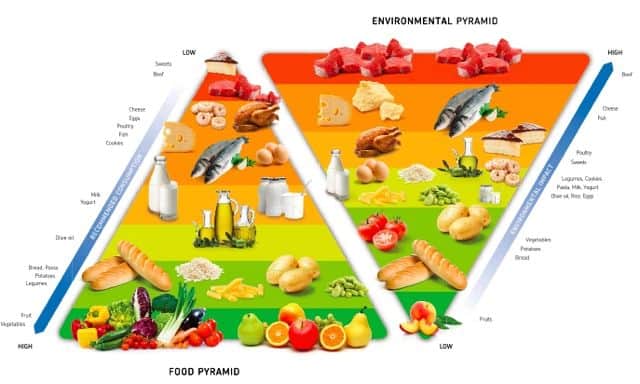The Double Pyramid, developed by the Barilla Center for Food & Nutrition (BCFN) in 2010, combines the traditional food pyramid with an additional environmental pyramid to depict both the nutritional and environmental impacts of food consumption.
Based on environmental indicators including greenhouse gas emissions and water consumption the environmental portion of the Double Pyramid is designed to showcase the environmental impacts associated with different food groups. The inverted pyramid’s bottom section depicts foods with minor environmental impacts, such as vegetables and fruits. As the pyramid widens, foods with larger ecological footprints are shown, such as meat, olive oil, and cheese. Red meat tops the pyramid as being the most resource-intensive and environmentally impactful food product. A recent study published in the Proceedings of the National Academy of Science reveals that, in the United States, beef production requires 28 times more land to produce than pork or chicken, 11 times more water, and creates five times more greenhouse gas emissions.
The food pyramid portion of the Double Pyramid is based on current nutritional science and visually represents which food groups should be consumed most for a healthy, balanced diet. While food pyramids can be simple and intuitive for the general public to understand, countries like the United States have made attempts to modernize their nutritional approach in light of soaring obesity rates. Now using the MyPlate dietary guideline, the U.S. Department of Agriculture (USDA) hopes better eating habits will reduce the current rate of obesity in the U.S., which stands at nearly 35 percent.
BCFN points out that, conveniently, the Double Pyramid allows eaters to see that, “the foods that are advised to be eaten more, are also, generally, those that have the lowest environmental impacts. On the other hand, foods that are advised to be eaten less are also those that have a greater environmental impact.”
However, there are some notable exceptions. Olive oil, esteemed for its heart-healthy fats, holds a higher place on the environmental pyramid than on the food pyramid. Increased product demand has led to the rapid expansion of olive groves, which has caused water shortages and soil erosion in Mediterranean regions. Consumers can sauté responsibly by buying domestic brands and by using more appropriate oils for different cooking methods. Conversely, flour and sugar based sweets may have a small ecological footprint, but are still best saved for dessert.
The Double Pyramid reimagines the way eaters calculate the consequences of their dietary choices. As the modern food system continues to wreak havoc on the environment, and as eaters continue to experience growing rates of obesity, the Double Pyramid can be a tool to conserve both the health of the planet and its people.















